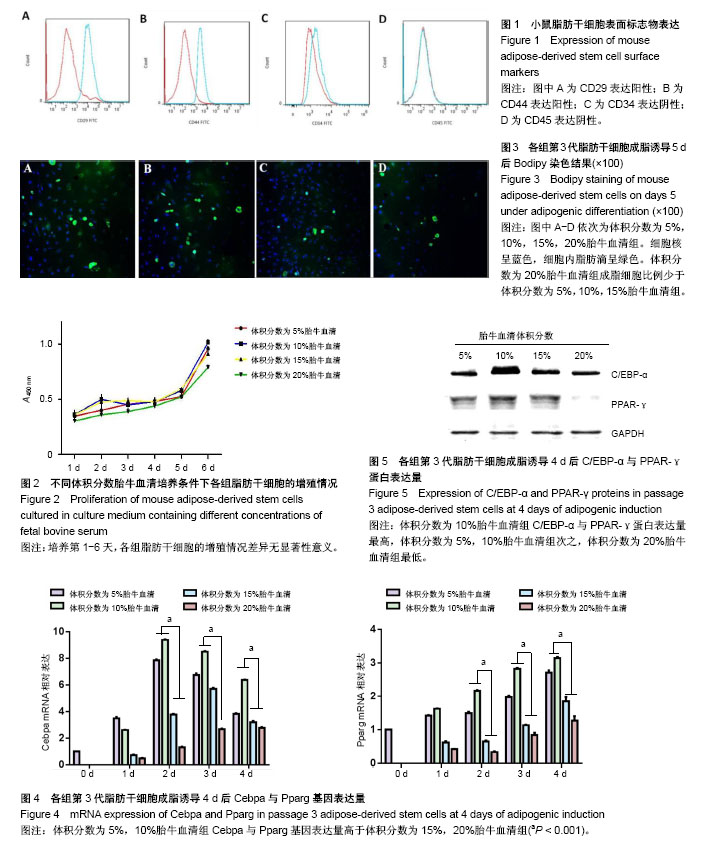| [1] Rodeheffer MS, Birsoy K, Friedman JM. Identification of white adipocyte progenitor cells in vivo. Cell. 2008;135(2):240-249.[2] Yoshimura K, Shigeura T, Matsumoto D, et al. Characterization of freshly isolated and cultured cells derived from the fatty and fluid portions of liposuction aspirates. J Cell Physiol. 2006; 208(1):64-76.[3] Nakao N, Nakayama T, Yahata T, et al. Adipose tissue-derived mesenchymal stem cells facilitate hematopoiesis in vitro and in vivo: advantages over bone marrow-derived mesenchymal stem cells. Am J Pathol. 2010; 177(2):547-554.[4] Harasymiak-Krzy?anowska I, Niedojad?o A, Karwat J, et al. Adipose tissue-derived stem cells show considerable promise for regenerative medicine applications. Cell Mol Biol Lett. 2013; 18(4):479-493.[5] Romagnoli C, Brandi ML. Adipose mesenchymal stem cells in the field of bone tissue engineering. World J Stem Cells. 2014; 6(2):144-152.[6] Tsuji W,Rubin JP,Marra KG. Adipose-derived stem cells: Implications in tissue regeneration. World J Stem Cells. 2014; 6(3):312-321.[7] 彭希亮,张玉红,倪文琼.脂肪组织来源干细胞构建皮肤复合组织修复创面缺损[J]. 中国组织工程研究,2016,20(1):8-12.[8] Bajek A, Gurtowska N, Olkowska J, et al. Adipose-Derived Stem Cells as a Tool in Cell-Based Therapies. Arch Immunol Ther Exp (Warsz). 2016;64(6):443-454.[9] 罗远,黄远亮.脂肪干细胞生物学特性及在口腔再生医学中的应用[J]. 中国组织工程研究,2017,21(5):795-801.[10] 李晓静,王佐林.脂肪干细胞在骨组织工程中的研究现状及应用前景[J].口腔颌面外科杂志,2016,26(3):216-221.[11] Bunnell BA, Flaat M, Gagliardi C, et al. Adipose-derived stem cells: isolation, expansion and differentiation.Methods. 2008; 45(2):15-120.[12] Dufrane D, Lafosse A. A Simple Method to Determine the Purity of Adipose-Derived Stem Cell-Based Cell Therapies. Stem Cells Transl Med. 2016;5(11):1575-1579.[13] Yang J, Xiong L, Wang R, et al. Adipose-derived stem cells from the breast. J Res Med Sci. 2014;19(2):112-116.[14] Riis S, Nielsen FM, Pennisi CP, et al. Comparative Analysis of Media and Supplements on Initiation and Expansion of Adipose-Derived Stem Cells. Stem Cells Transl Med. 2016; 5(3):314-324.[15] 宋亮.不同浓度胎牛血清对大鼠髓核间充质干细胞生物学特性影响[D].太原:山西医科大学,2014.[16] 孙国栋.不同浓度胎牛血清培养下骨髓间充质干细胞诱导为心肌样细胞的比较[D].太原:山西医科大学,2015.[17] 杨军.不同血清浓度培养基对小鼠骨髓干细胞生物特征的影响[J]. 广西医学,2015,37(10):1384-1386.[18] Farmer SR. Molecular determinants of brown adipocyte formation and function. Genes Dev. 2008;22(10):1269-1275.[19] Carobbio S, Rosen B, Vidal-Puig A. Adipogenesis: new insights into brown adipose tissue differentiation. J Mol Endocrinol. 2013;51(3):T75-85.[20] Lowe CE, O'Rahilly S, Rochford JJ. Adipogenesis at a glance. J Cell Sci. 2011;124(Pt 16):2681-2686.[21] 陈犹白,郝永红,王岚,等.脂肪干细胞成脂分化的分子机制和信号通路[J].中国组织工程研究,2017,21(1):154-158.[22] 关于发布《关于善待实验动物的指导性意见》的通知[J].畜牧兽医科技信息,2007(4):35-36.[23] Zuk PA, Zhu M, Ashjian P, et al. Human adipose tissue is a source of multipotent stem cells. Mol Biol Cell. 2002;13(12): 4279-4295.[24] Lee JS, Mendez R, Heng HH, et al. Pharmacological ER stress promotes hepatic lipogenesis and lipid droplet formation. Am J Transl Res. 2012;4(1):102-113.[25] Shafaghat F, Abbasi-Kenarsari H, Majidi J, et al. Preparation of Proper Immunogen by Cloning and Stable Expression of cDNA coding for Human Hematopoietic Stem Cell Marker CD34 in NIH-3T3 Mouse Fibroblast Cell Line. Adv Pharm Bull. 2015;5(1):69-75.[26] Zhang LJ, Guerrero-Juarez CF, Hata T, et al. Innate immunity. Dermal adipocytes protect against invasive Staphylococcus aureus skin infection. Science. 2015;347(6217):67-71.[27] 葛敏,蒋朝华,戴婷婷,等.不同血清浓度对淋巴管内皮细胞培养的影响[J].组织工程与重建外科杂志,2013,9(3):121-124.[28] 何丁文,殷嫦嫦,殷明,等.不同血清浓度对bFGF联合EGF诱导BMSCs向神经细胞分化的影响[J].神经解剖学杂志,2013,29(1): 18-24.[29] 张雪莲,马依彤,王常勇,等.大鼠脂肪干细胞的分离培养及基本生物学性状研究[J].细胞与分子免疫学杂志,2010,26(12): 1217-1219.[30] 雷蕙嘉,孙建军,彭本刚,等. 大鼠脂肪干细胞的分离培养及鉴定的初步研究[J]. 中国实验诊断学,2011,15(8):1245-1248.[31] 郝艳红,李敏,杨军.血清浓度对小鼠骨髓干细胞生物特征的影响[J]. 河南科技大学学报:医学版,2015,33(1):19-20.[32] 张扬,刘大诚,杨效宁.不同培养条件下脂肪干细胞与成骨细胞的共培养[J].中国组织工程研究,2014,18(37):6003-6007.[33] 陶凯,刘晓燕,梁久龙,等.人脂肪组织来源干细胞体外培养条件的优化[J].中国美容整形外科杂志,2007,18(3):223-226.[34] 胡声锁,胡蕴玉,魏义勇,等.血清浓度对脂肪成体干细胞向软骨细胞分化的影响[J].中国矫形外科杂志,2007,15(11):860-862.[35] 张树威,陈安民,宋登新,等.不同浓度血清对大鼠骨骺干细胞向软骨细胞分化的诱导效果比较[J].中国组织工程研究与临床康复, 2008,12(34):6617-6620.[36] 玉石,刘卫平,刘阳,等.不同血清浓度下人骨髓间充质干细胞定向分化为神经元样细胞的实验研究[J]. 立体定向和功能性神经外科杂志,2009,22(5):274-278.[37] 徐静娟. 离体细胞的培养条件[J]. 江南大学学报:自然科学版, 2002,1(1):94-96. |
.jpg)

.jpg)
.jpg)